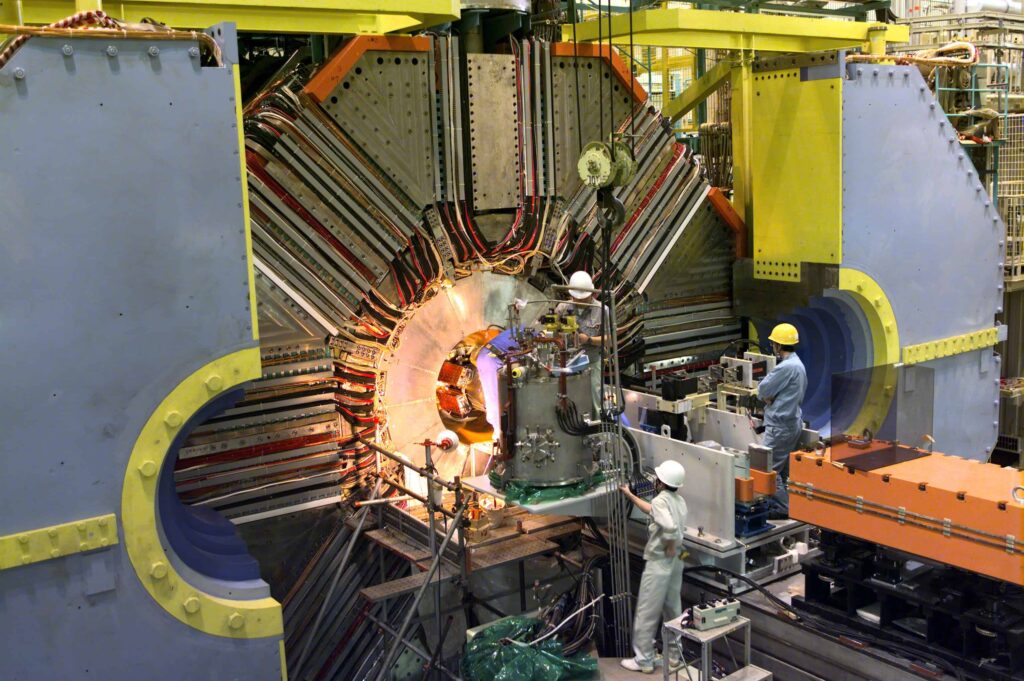Scientists and technicians insert one of the optical components into the iTOP particle identification detector at the SuperKEKB accelerator in Japan. The “Imaging Time of Propagation” apparatus, or iTOP, is part of SuperKEKB’s Belle II detector. (Credit: PNNL)
What happened to all the antimatter? A particle-smasher in Japan is well on its way to addressing that question and others on the frontier of physics.
The SuperKEKB accelerator is designed to smash together tightly focused beams of electrons and anti-electrons (better known as positrons) and track the subatomic particles that wink in and out of existence as a result.
The collider will follow up on an earlier round of experiments at the KEK laboratory in Tsukuba. Over the past five years, KEK’s 1.9-mile-round (3-kilometer-round) underground ring has been upgraded to produce collisions at a rate 40 times higher than the earlier KEKB experiments did. Europe’s Large Hadron Collider may smash protons together at higher energies, but SuperKEKB will trump the LHC when it comes to the “Intensity Frontier.”
On Feb. 10, scientists circulated a beam of positrons around the SuperKEKB ring at nearly the speed of light. Then, on Feb. 26, they sent a separate beam of electrons at similar velocities, but going in the opposite direction. These “first turns” serve as major milestones on the way to next year’s first physics run, when both beams will circulate simultaneously and smash into each other in SuperKEKB’s upgraded Belle II detector.

More than 600 scientists from 23 countries are involved in the Belle II collaboration. That number includes about 75 U.S. scientists, and the Department of Energy’s Pacific Northwest National Laboratory in Richland, Wash., is playing a leading role.
“The purpose of Belle II is to help us understand new physics beyond the Standard Model,” PNNL’s Jim Fast, the project manager for the U.S. contribution to the project, said in a news release. “Our approach is to focus on very rare decay processes with great precision to seek answers.”
SuperKEKB is expected to produce an abundance of two types of particles known as B mesons and tau leptons. Those heavy particles decay quickly, but the patterns of those decays could reveal new physics.
Earlier observations at KEKB and at another experiment known as BaBar showed that B mesons and anti-B mesons decay in different ways. That helped explain one of the puzzles surrounding antimatter: Theoretically, equal amounts of matter and antimatter should have come into existence at the birth of the universe. But today, antimatter is rarely seen in the natural world. Matter may have won out in the early universe because of the asymmetry in the patterns of particle decay.
Physicists shared a Nobel Prize in 2008 for working out some of the theories behind the phenomenon, but in order to probe the mystery more deeply, scientists need much more data. That’s what SuperKEKB should provide.
The matter-antimatter mystery is only one of the issues scientists plan to address at the accelerator. SuperKEKB and Belle II could also help scientists learn more about the nature of dark matter, the invisible stuff that accounts for more than 80 percent of the universe’s mass.
GeekWire contributing editor Alan Boyle is an award-winning science writer and veteran space reporter. Formerly of NBCNews.com, he is the author of “The Case for Pluto: How a Little Planet Made a Big Difference.” Follow him via CosmicLog.com, on Twitter @b0yle, and on Facebook and MeWe. Reach him via email at alan@geekwire.com.
Yes, startups can afford health care!
ALLtech helps growing technology companies recruit and retain top talent, with comprehensive, affordable health insurance and other employee benefits. Whether you have two employees or more than 100, we have a benefit plan to fit your needs.
Request a quote from ALLtech Benefits.
